Submitted:
13 June 2023
Posted:
14 June 2023
You are already at the latest version
Abstract
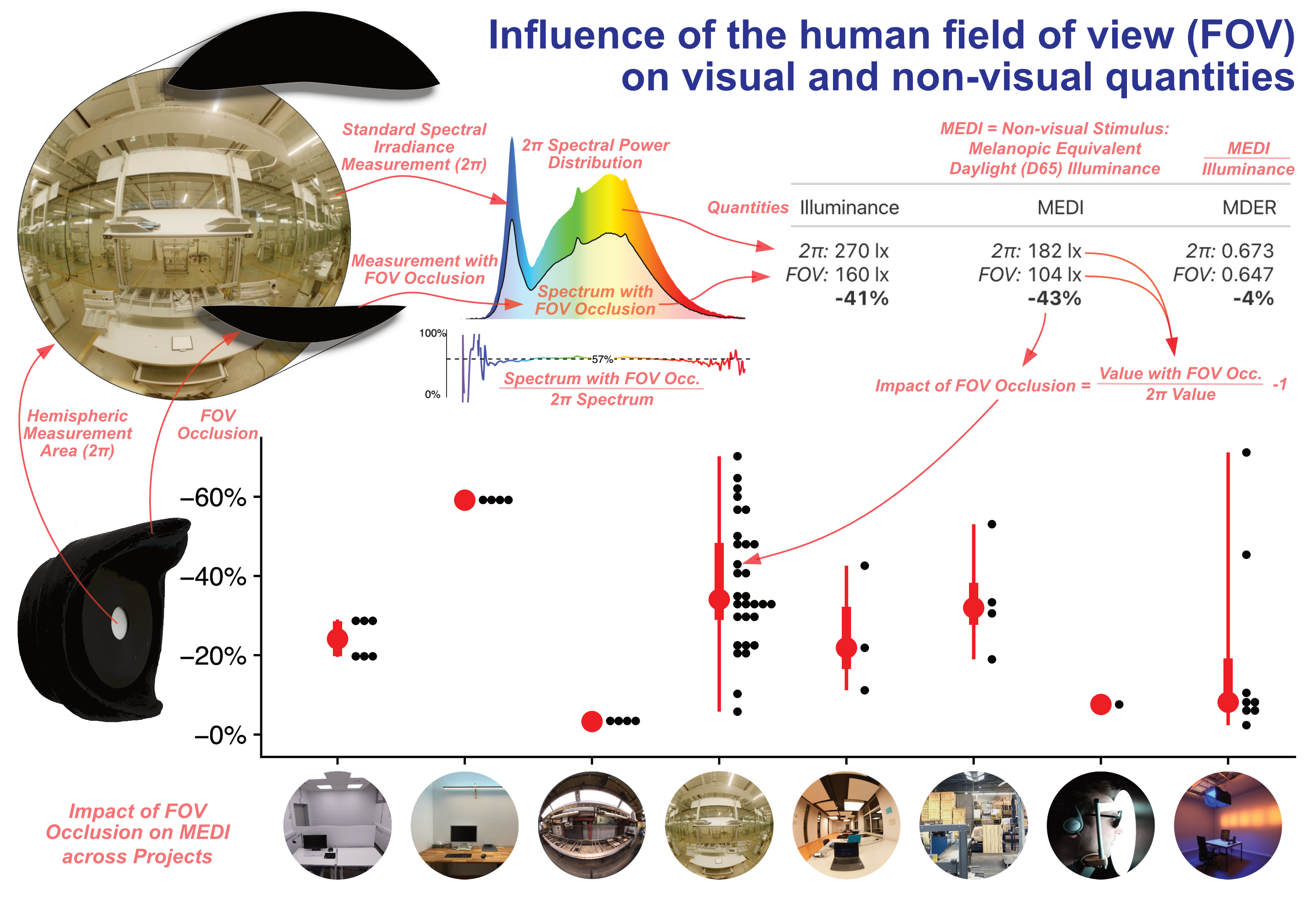
Keywords:
1. Introduction
2. Results
2.1. Overview
2.2. Project Results for Scenarios 1-20
2.2.1. Project A: Realistic Office Lab Study, Scenarios 1-3
2.2.2. Project B: Home Office Workplace, Scenarios 4-6
2.2.3. Project C: Industry Field Study (Machine Workplace), Scenarios 7-8
2.2.4. Project D: Industry Workplace, Scenarios 9-10
2.2.5. Project E: Learning Space, Scenarios 11-13
2.2.6. Project F: Industry Field Study (Packaging Workplace), Scenarios 14-16
2.2.7. Project G: Halfdome Ganzfeld Lab Setup, Scenario 17
2.2.8. Project H: Artificial Office Lab Study, Scenarios 18-20
2.3. Impact of head orientation (Project D)
3. Discussion
- FOV occlusion is highly relevant for the visual and non-visual stimulus intensities in the context of realistic light-source positioning (mostly 20% to 60% reduction).
- Notable Edge cases lead to a particularly high or low impact from occlusion (as low as -3% impact, to as high as -71%).
- FOV occlusion seems largely irrelevant for the spectral distribution (MDER). Only artificially constructed scenarios mattered in that regard, but it might also matter in spectrally diverse scenarios that were outside the scope of our projects.
- FOV occlusion is highly relevant in interaction with the head orientation. (as low as -6% impact, to as high as -57% for the same scenario, just by tilting the sensor)
3.1. Summarizing project results
- Dimming and tunable white:
-
Changing the spectrum of light (correlated color temperature (CCT) shift) across all lights in a scene the same way does not change the impact of FOV occlusion (Scenario 1-2, all about -29%).Changing the light output across all lights in a scene the same way does not change the impact of FOV occlusion (Scenario 2-3, all about -29%).
- Direct/indirect lighting:
- Changing the direction of light and spectral distribution outside the FOV does not necessarily change the impact of FOV occlusion (Scenario 4-6, all about -60%), but see below under Spotlights and panels.
- Changing the direction of light and spectral distribution within the FOV does not necessarily change the impact of FOV occlusion (Scenario 7-8, all about -3%)
- Installation height:
- High mounted lights will have a large impact on FOV occlusion (Scenario 4-6 & 9, up to -60%), but the impact can be reduced by wide beam lights in larger rooms, where more lights are visible at a lower viewing angle (Scenario 1-3, about -29%; scenario 12, about -22%).
- Low mounted or desk lighting will reduce the impact on FOV occlusion (Scenario 7-8, about -3%; scenario 10: -43% compared to scenario 9: -60%)
- Spotlight and panel-light fixtures:
- Mixing spot and panel-light fixtures in dynamic lighting can produce beneficial effects through FOV occlusion. In scenario 11 the goal is to maximize MEDI: The dominant panel lights illuminate the room evenly and lead to little FOV occlusion impact (-11%). In scenario 13 the goal is to minimize MEDI: The dominant spotlights illuminate mainly the desk surface, but the light source above the desk is also a large contributor to the standard 2π geometry. The FOV occludes this part, however, and thus reduces the MEDI further (-43%). The resulting dynamic MEDI range thus increases from the 2π geometry (242 lx/54 lx: factor 4.5) when adjusting for the FOV occlusion (215 lx/31 lx: factor 6.9)
- Mixing spot and panel-light fixtures in dynamic lighting can produce detrimental effects through FOV occlusion. In scenario 14 the goal is to maximize MEDI: the dominant light panels are only above the observer, however, and don´t illuminate the large hall (-53%). As MEDI values are supposed to get lower (Scenario 15-16), the panel lights are dimmed in favor of the spotlight fixtures – those do little, however, in lowering the light coming from the rest of the production hall (-19%). The resulting dynamic MEDI range is thus reduced from the 2π geometry (322 lx/97 lx: factor 3.3) when adjusting for the FOV occlusion (151 lx/79 lx: factor 1.9).
- Head orientation (subsection 2.3):
- (Near) vertical measurements lead to the highest FOV occlusion impact (Y±0: -43; Y+15: -57%), whereas large tilts up- and downwards reduce the impact considerably (Y+45°: -6%; Y-45°: -29%). We find it likely that this tendency is generalizable for typical workplace settings with overhead lighting (see 2.3 for more on this reasoning). While changes along the horizontal axis influenced FOV occlusion as well, we don´t believe this can be generalized beyond our measurements.
- Miscellaneous:
- Ganzfeld setups are small but not negligible in terms of the FOV occlusion impact (Scenario 17, -8%), and real-world settings can have lower occlusion (Scenario 7-8, about -3%).
-
The FOV occlusion reduces spectral irradiance by about the same amount regardless of wavelength (rSPD for scenarios 1-18). Thus visual, and non-visual quantities are also reduced in the same manner and changes in MDER are negligible.This was not obvious to us as a common staple from the start. We believed that different spectral light or reflectance properties inside the FOV compared to outside might lead to significant deviations across the spectrum and thus MDER. While the surfaces in some projects are all neutral in their reflectance properties (Scenario 1-3, 7-10), in others they are not (e.g., wooden desk in scenario 4-6; or wooden crates within the FOV in scenario 14-16). However, only when artificially forcing strong differences in spectral distribution, did we see an effect (Scenario 18-20). Similar effects might happen in very colorful settings.
3.2. Limitations
3.3. Further Discussions and Outlook
4. Materials and Methods
4.1. FOV occlusion
4.2. Measurement Apparatus
4.3. Projects and Measurements
4.4. Data Analysis
Supplementary Materials
Author Contributions
Funding
Data Availability Statement
Acknowledgments
Conflicts of Interest
Appendix A – Project Descriptions
Project A: Realistic Office Lab Study, Scenarios 1-3
Project B: Home Office Workplace, Scenarios 4-6
Project C: Industry Field Study (Machine Workplace), Scenarios 7-8
Project D: Industry Workplace, Scenarios 9-10
Project E: Learning Space, Scenarios 11-13
Project F: Industry Field Study (Packaging Workplace), Scenarios 14-16
Project G: Halfdome Ganzfeld Lab Setup, Scenario 17
Project H: Artificial Office Lab Study, Scenarios 18-20
References
- Brown TM. Melanopic illuminance defines the magnitude of human circadian light responses under a wide range of conditions. J Pineal Res. 2020:e12655. Epub 2020/04/06. [CrossRef]
- Spitschan M, Smolders K, Vandendriessche B, Bent B, Bakker JP, Rodriguez-Chavez IR, et al. Verification, analytical validation and clinical validation (V3) of wearable dosimeters and light loggers. Digit Health. 2022;8:20552076221144858. Epub 20221225. [CrossRef]
- CIE. CIE S 026/E:2018. CIE system for metrology of optical radiation for ipRGC-influenced responses of light. In: CIE, editor. CIE S 026/E:2018. Vienna: CIE; 2018.
- Broszio K, Knoop M, Niedling M, Völker S. Effective radiant flux for non-image forming effects—Is the illuminance and the melanopic irradiance at the eye really the right measure. Light Eng. 2018;26(2):68-74. [CrossRef]
- Babilon S, Beck S, Kunkel J, Klabes J, Myland P, Benkner S, et al. Measurement of Circadian Effectiveness in Lighting for Office Applications. Applied Sciences. 2021;11(15). [CrossRef]
- Knoop M, Broszio K, Diakite A, Liedtke C, Niedling M, Rothert I, et al. Methods to Describe and Measure Lighting Conditions in Experiments on Non-Image-Forming Aspects. Leukos. 2019;15(2-3):163-79. [CrossRef]
- Sliney DH, Mellerio J. Safety with lasers and other optical sources: a comprehensive handbook: Springer Science & Business Media; 2013. [CrossRef]
- Guth, S. Light and comfort. Industrial medicine & surgery. 1958;27(11):570-4.
- Parker Jr JF, West VR. Bioastronautics data book. NASA, 1973.
- Strasburger, H. Seven Myths on Crowding and Peripheral Vision. Iperception. 2020;11(3):2041669520913052. Epub 2020/06/04. [CrossRef]
- Rönne, H. Zur theorie und technik der Bjerrumschen gesichtsfelduntersuchung. Archiv für Augenheilkunde. 1915;78(4):284-301.
- Bieske K, Schuppert B, Schierz C, editors. Einfluss der Blickrichtung auf die Messung von nichtvisuellen Lichtwirkungen. LICHT2023: 25 europäischer Lichttechnischer Kongress; 2023; Salzburg2023.
- Brown TM, Brainard GC, Cajochen C, Czeisler CA, Hanifin JP, Lockley SW, et al. Recommendations for daytime, evening, and nighttime indoor light exposure to best support physiology, sleep, and wakefulness in healthy adults. PLoS Biol. 2022;20(3):e3001571. Epub 20220317. [CrossRef]
- Cajochen C, Zeitzer JM, Czeisler CA, Dijk D-J. Dose-response relationship for light intensity and ocular and electroencephalographic correlates of human alertness. Behavioural Brain Research. 2000;115(1):75-83. [CrossRef]
- Zeitzer JM, Dijk DJ, Kronauer R, Brown E, Czeisler C. Sensitivity of the human circadian pacemaker to nocturnal light: melatonin phase resetting and suppression. The Journal of physiology. 2000;526 Pt 3(Pt 3):695-702. [CrossRef]
- Brainard GC, Hanifin JP, Greeson JM, Byrne B, Glickman G, Gerner E, et al. Action Spectrum for Melatonin Regulation in Humans: Evidence for a Novel Circadian Photoreceptor. The Journal of Neuroscience. 2001;21(16):6405-12. [CrossRef]
- Brown TM, Thapan K, Arendt J, Revell VL, Skene DJ. S-cone contribution to the acute melatonin suppression response in humans. J Pineal Res. 2021:e12719. Epub 2021/01/30. [CrossRef]
- Wright HR, Lack LC. Effect of Light Wavelenght on Suppression and Phase Delay of the Melatonin Rhythm. Chronobiology International. 2001;18(5):801-8. [CrossRef]
- Revell VL, Skene DJ. Light-Induced Melatonin Suppression in Humans with Polychromatic and Monochromatic Light. Chronobiology International. 2007;24(6):1125-37. [CrossRef]
- Brainard GC, Sliney D, Hanifin JP, Glickman G, Byrne B, Greeson JM, et al. Sensitivity of the Human Circadian System to Short-Wavelength (420-nm) Light. Journal of Biological Rhythms. 2008;23(5):379-86. [CrossRef]
- Gooley JJ, Rajaratnam SMW, Brainard GC, Kronauer RE, Czeisler CA, Lockley SW. Spectral Responses of the Human Circadian System Depend on the Irradiance and Duration of Exposure to Light. Science Translational Medicine. 2010;2(31):31ra3-ra3. [CrossRef]
- Revell VL, Barrett DCG, Schlangen LJM, Skene DJ. Predicting Human Nocturnal Nonvisual Responses to Monochromatic and Polychromatic Light with a Melanopsin Photosensitivity Function. Chronobiology International. 2010;27(9-10):1762-77. [CrossRef]
- Santhi N, Thorne HC, van der Veen DR, Johnsen S, Mills SL, Hommes V, et al. The spectral composition of evening light and individual differences in the suppression of melatonin and delay of sleep in humans. Journal of Pineal Research. 2012;53(1):47-59. [CrossRef]
- Papamichael C, Skene DJ, Revell VL. Human nonvisual responses to simultaneous presentation of blue and red monochromatic light. J Biol Rhythms. 2012;27(1):70-8. [CrossRef]
- Chellappa SL, Steiner R, Blattner P, Oelhafen P, Götz T, Cajochen C. Non-visual effects of light on melatonin, alertness and cognitive performance: can blue-enriched light keep us alert? PLOS ONE. 2011;6(1):e16429. [CrossRef]
- Ho Mien I, Chua EC, Lau P, Tan LC, Lee IT, Yeo SC, et al. Effects of exposure to intermittent versus continuous red light on human circadian rhythms, melatonin suppression, and pupillary constriction. PLoS One. 2014;9(5):e96532. Epub 20140505. [CrossRef]
- Najjar RP, Chiquet C, Teikari P, Cornut PL, Claustrat B, Denis P, et al. Aging of non-visual spectral sensitivity to light in humans: compensatory mechanisms? PLoS One. 2014;9(1):e85837. Epub 2014/01/28. [CrossRef]
- Brainard GC, Hanifin JP, Warfield B, Stone MK, James ME, Ayers M, et al. Short-wavelength enrichment of polychromatic light enhances human melatonin suppression potency. Journal of pineal research. 2015;58(3):352-61. [CrossRef]
- Rahman SA, St. Hilaire MA, Lockley SW. The effects of spectral tuning of evening ambient light on melatonin suppression, alertness and sleep. Physiology & Behavior. 2017;177:221-9. [CrossRef]
- Hanifin JP, Lockley SW, Cecil K, West K, Jablonski M, Warfield B, et al. Randomized trial of polychromatic blue-enriched light for circadian phase shifting, melatonin suppression, and alerting responses. Physiology & Behavior. 2019;198:57-66. [CrossRef]
- Nagare R, Rea MS, Plitnick B, Figueiro MG. Nocturnal Melatonin Suppression by Adolescents and Adults for Different Levels, Spectra, and Durations of Light Exposure. J Biol Rhythms. 2019;34(2):178-94. Epub 20190225. [CrossRef]
- Phillips AJK, Vidafar P, Burns AC, McGlashan EM, Anderson C, Rajaratnam SMW, et al. High sensitivity and interindividual variability in the response of the human circadian system to evening light. Proc Natl Acad Sci U S A. 2019;116(24):12019-24. Epub 2019/05/30. [CrossRef]
- Zauner J, Plischke H, Stijnen H, Schwarz UT, Strasburger H. Influence of common lighting conditions and time-of-day on the effort-related cardiac response. PloS One. 2020;15(10). [CrossRef]
- Ru T, Smolders K, Chen Q, Zhou G, de Kort Y. Diurnal effects of illuminance on performance: Exploring the moderating role of cognitive domain and task difficulty. Lighting Research & Technology. 2022;0(0):1477153521990645. [CrossRef]
- Baandrup L, Jennum PJ. Effect of a dynamic lighting intervention on circadian rest-activity disturbances in cognitively impaired, older adults living in a nursing home: A proof-of-concept study. Neurobiology of Sleep and Circadian Rhythms. 2021;11. [CrossRef]
- van Duijnhoven J, Aarts M, Kort H. Personal lighting conditions of office workers: An exploratory field study. Lighting Research & Technology. 2020;0(0):1477153520976940. [CrossRef]
- Zauner J, Plischke H. Designing Light for Night Shift Workers: Application of Nonvisual Lighting Design Principles in an Industrial Production Line. Applied Sciences. 2021;11(22). [CrossRef]
- Plischke H, Linek M, Zauner J. The opportunities of biodynamic lighting in homes for the elderly. Current Directions in Biomedical Engineering. 2018;4(1):123-6. [CrossRef]
- Van de Putte E, Kindt S, Bracke P, Stevens M, Vansteenkiste M, Vandevivere L, et al. The influence of integrative lighting on sleep and cognitive functioning of shift workers during the morning shift in an assembly plant. Applied Ergonomics. 2022;99:103618. [CrossRef]
- SpectroMasks [Internet]. 2023. [CrossRef]
- Lasko TA, Kripke DF, Elliot JA. Melatonin Suppression by Illumination of Upper and Lower Visual Fields. Journal of Biological Rhythms. 1999;14(2):122-5. [CrossRef]
- He S, Li H, Yan Y, Cai H. Capturing Luminous Flux Entering Human Eyes with a Camera, Part 1: Fundamentals. Leukos. 2022:1-19. [CrossRef]
- He S, Li H, Yan Y, Cai H. Capturing Luminous Flux Entering Human Eyes with a Camera, Part 2: A Field Verification Experiment. Leukos. 2023:1-27. [CrossRef]
- Kooijman, AC. Light distribution on the retina of a wide-angle theoretical eye. J Opt Soc Am. 1983;73(11):1544-50. [CrossRef]
- Schierz C, editor Zur Photometrie nichtvisueller Lichtwirkungen. Proc 2008 Symposium “Licht und Gesundheit; 2008.
- Van Derlofske JF, Bierman A, Rea MS, Maliyagoda N, editors. Design and optimization of a retinal exposure detector. Novel Optical Systems Design and Optimization III; 2000: SPIE.
- John Van D, Andrew B, Mark SR, Janani R, John DB. Design and optimization of a retinal flux density meter. Measurement Science and Technology. 2002;13(6):821. [CrossRef]
- Veitch JA, Knoop M. CIE TN 011:2020. What to document and report in studies of ipRGC-influenced responses to light. CIE TN 011:2020. Vienna: CIE; 2020.
- Zauner J, Plischke H, Strasburger H. Spectral dependency of the human pupillary light reflex. Influences of pre-adaptation and chronotype. PLoS One. 2022;17(1):e0253030. Epub 20220112. [CrossRef]
- DIN. DIN SPEC 67600:2022-08. Complementary criteria for lighting design and lighting application with regard to non-visual effects of light. DIN SPEC 67600:2022-08. Berlin: Beuth Publishing Company; 2022.
- R Core Team. R: a language and environment for statistical computing. Vienna, Austria: R Foundation for Statistical Computing; 2017.
- Rolf H, Udovicic L, Völker S, editors. Effects of Light on Attention during the Day: Spectral Composition and Exposure Duration. Lux junior 2021: 15 Internationales Forum für den lichttechnischen Nachwuchs, 04–06 Juni 2021, Ilmenau: Tagungsband; 2021.
- Rolf H, Udovicic L, Völker S, editors. Einfluss des Lichts auf die Aufmerksamkeit am Tag: Spektrale Zusammensetzung und Expositionsdauer. LICHT2021: 24 Europäischer Lichtkongress der lichttechnischen Gesellschaften Deutschlands, der Niederlande, Österreichs und der Schweiz; 2021; Bamberg.
- Zauner, J. Ocular light effects on human autonomous function: the role of intrinsically photosensitive retinal ganglion cell sensitivity and time of day [Dissertation, LMU München]2022.
- Broszio K, Knoop M, Völker S, editors. Einfluss der Lichteinfallsrichtung auf die akute Aufmerksamkeit. 10 Symposium Licht und Gesundheit; 2019.
- Broszio K, Bieske K, Zauner J, editors. Untersuchung zum Einfluss des menschlichen Gesichtsfelds auf nichtvisuelle Größen. Proceedings of LICHT2023: 25 europäischer Lichttechnischer Kongress; 2023.
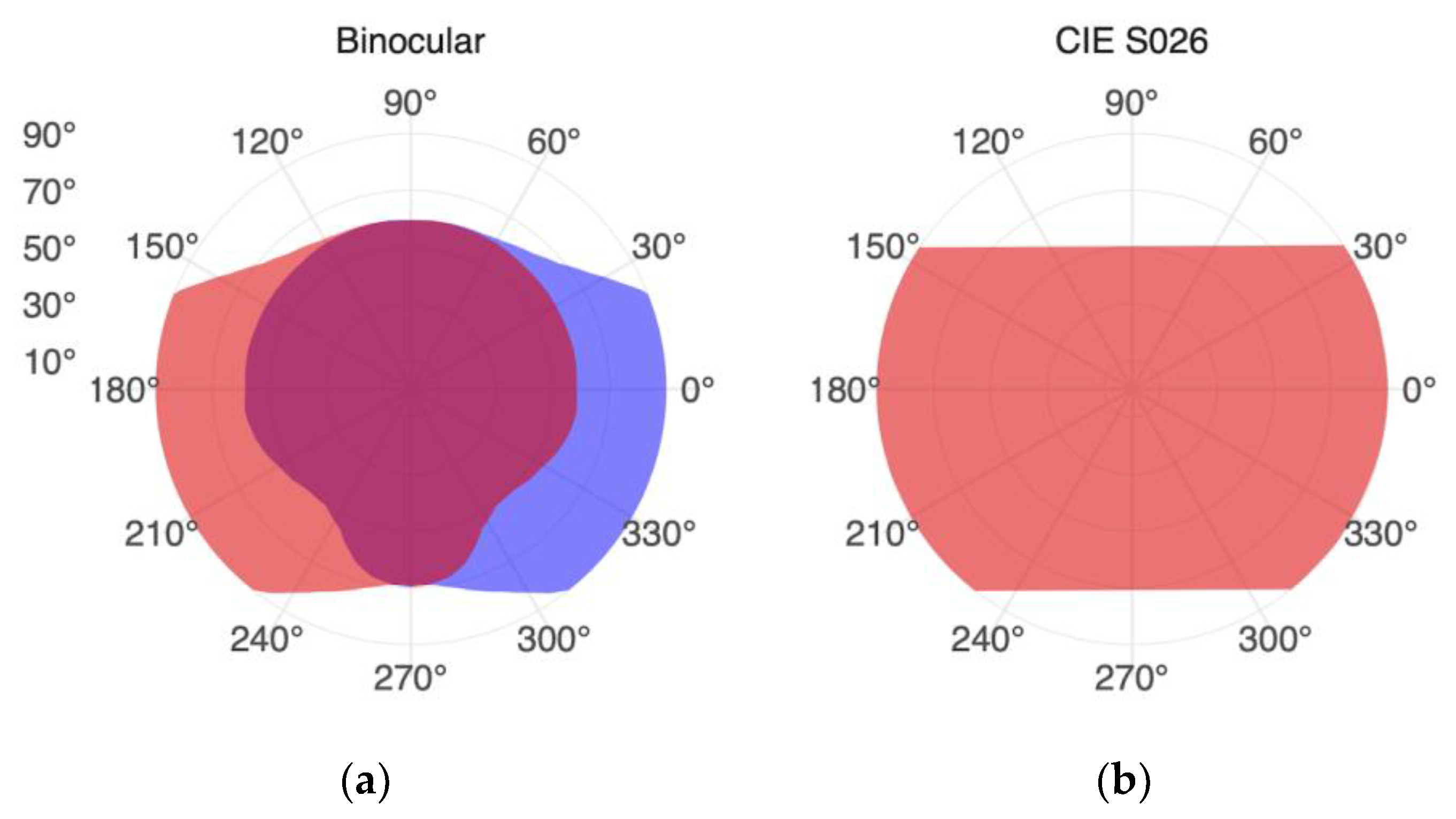
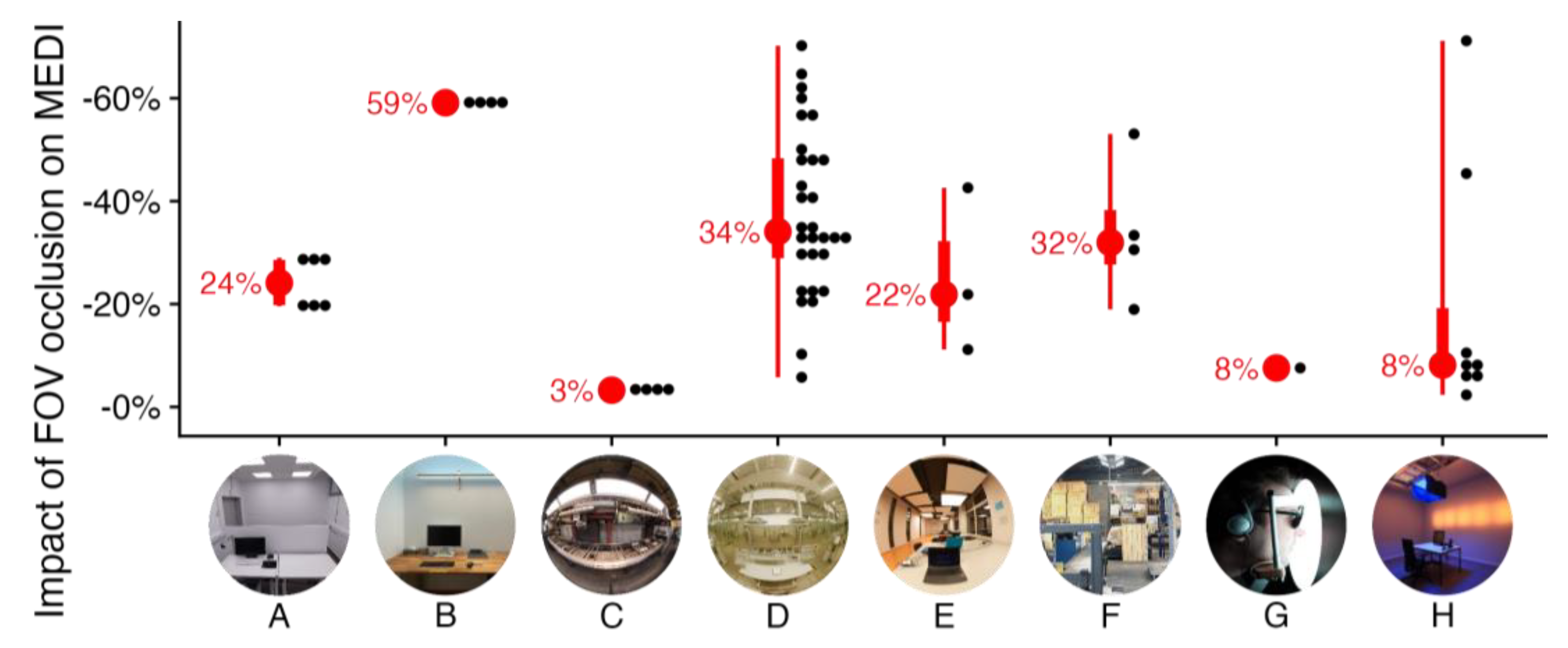
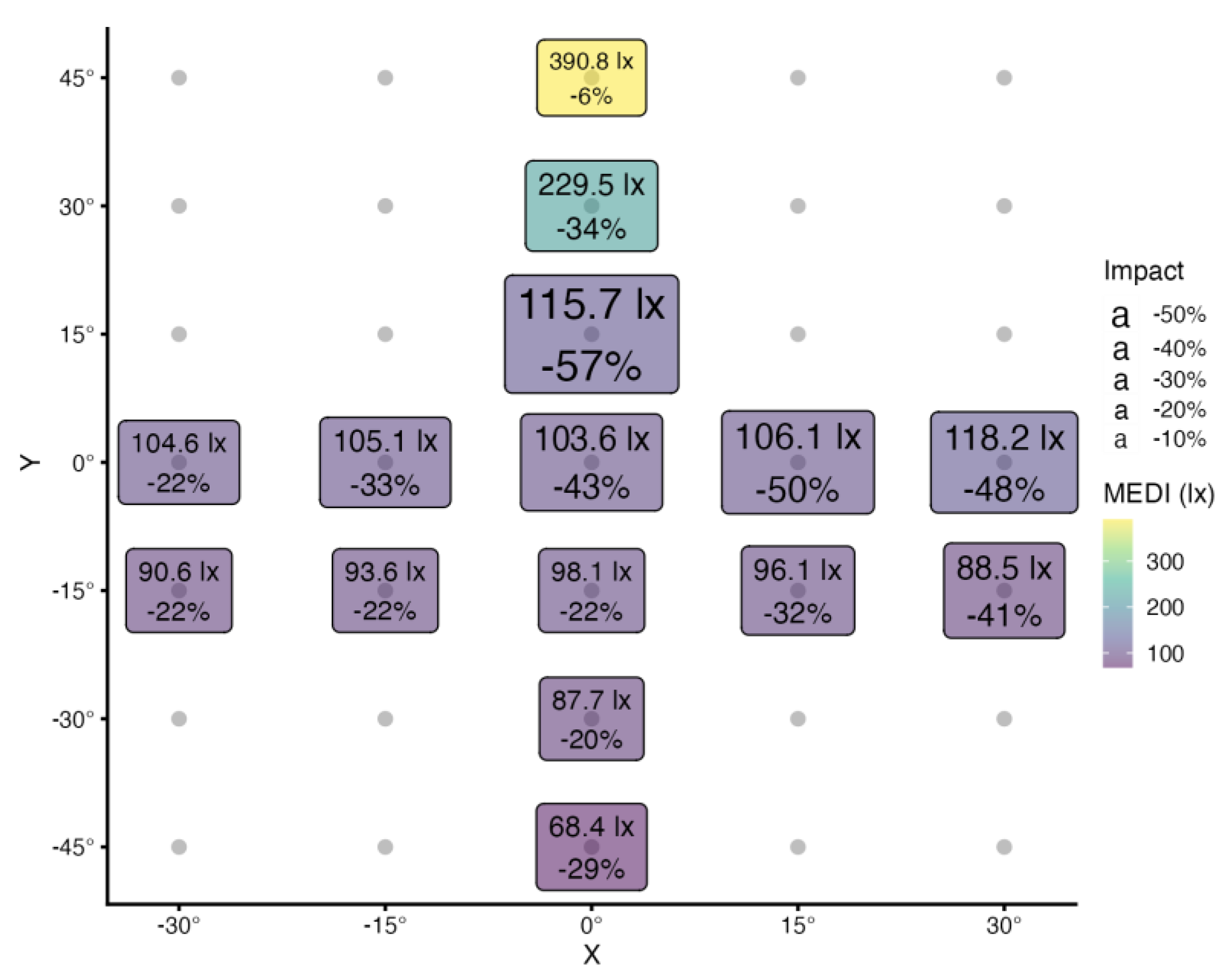

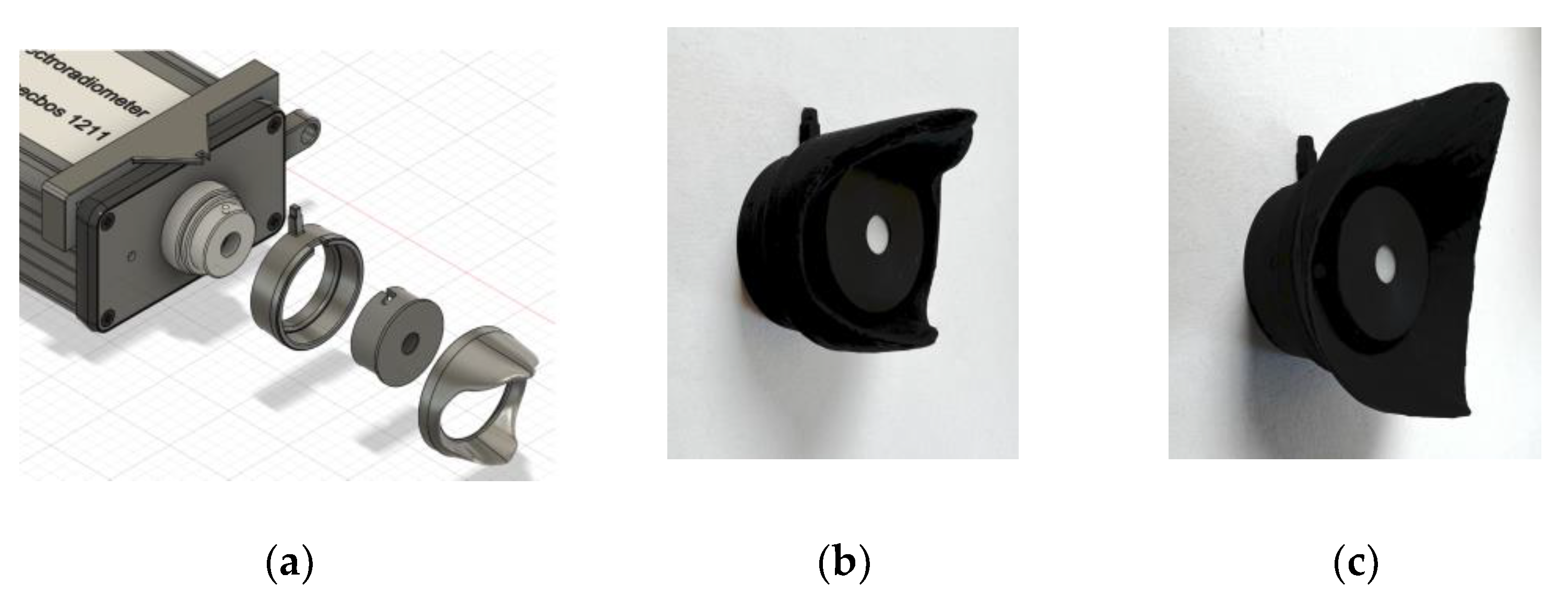
| Citation | Light Incidence1 |
|---|---|
| Cajochen et al. 2000 [14] | Not stated |
| Zeitzer et al. 2000 [15] | Ceiling Mounted Lights2 |
| Brainard et al. 2001 [16] | Ganzfeld Dome |
| Thapan et al. 2001 [17] | Ganzfeld Dome |
| Wright and Lack 2001 [18] | Low-Central, 20° visual angle |
| Revell and Skene 2007 [19] | Ganzfeld Dome |
| Brainard et al. 2008 [20] | Ganzfeld Dome |
| Gooley et al. 2010 [21] | Ganzfeld Dome |
| Revell et al. 2010 [22] | Ganzfeld Dome |
| Santhi et al. 2010 [23] | Central, Light Box |
| Papamichael et al. 2012 [24] | Ganzfeld Dome |
| Chellapa et al. 2014 [25] | Ganzfeld Room |
| Ho Mien et al. 2014 [26] | Ganzfeld Dome |
| Najjar et al. 2014 [27] | Ganzfeld Dome |
| Brainard et al. 2015 [28] | Central, 63° viewing angle |
| Rahman et al. 2017 [29] | Wall mounted Lights |
| Hanifin et al. 2019 [30] | Central, 63° visual angle |
| Nagare et al. 2019 [31] | Central, 40° viewing angle |
| Phillips et al. 2019 [32] | Ceiling mounted Lights |
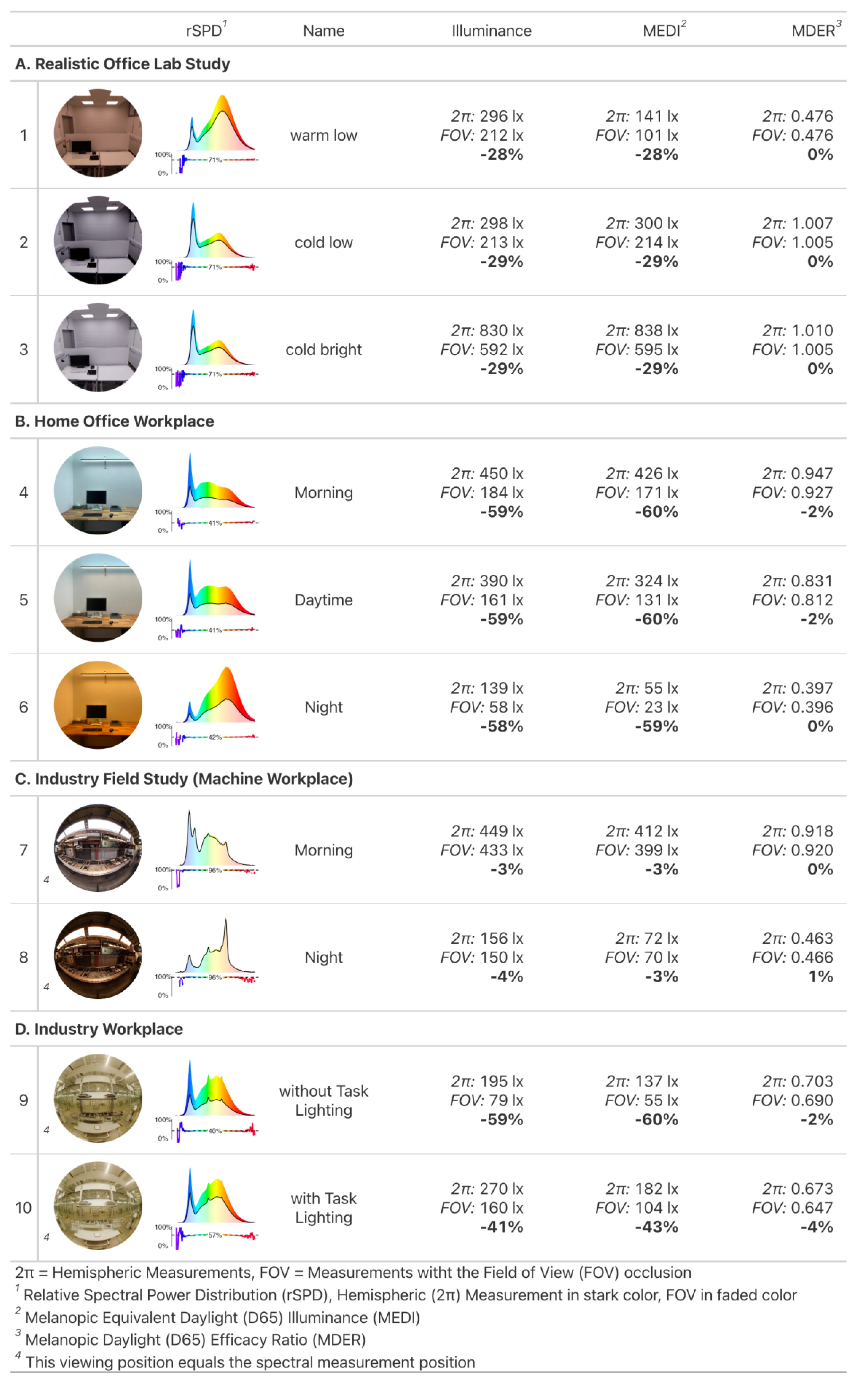
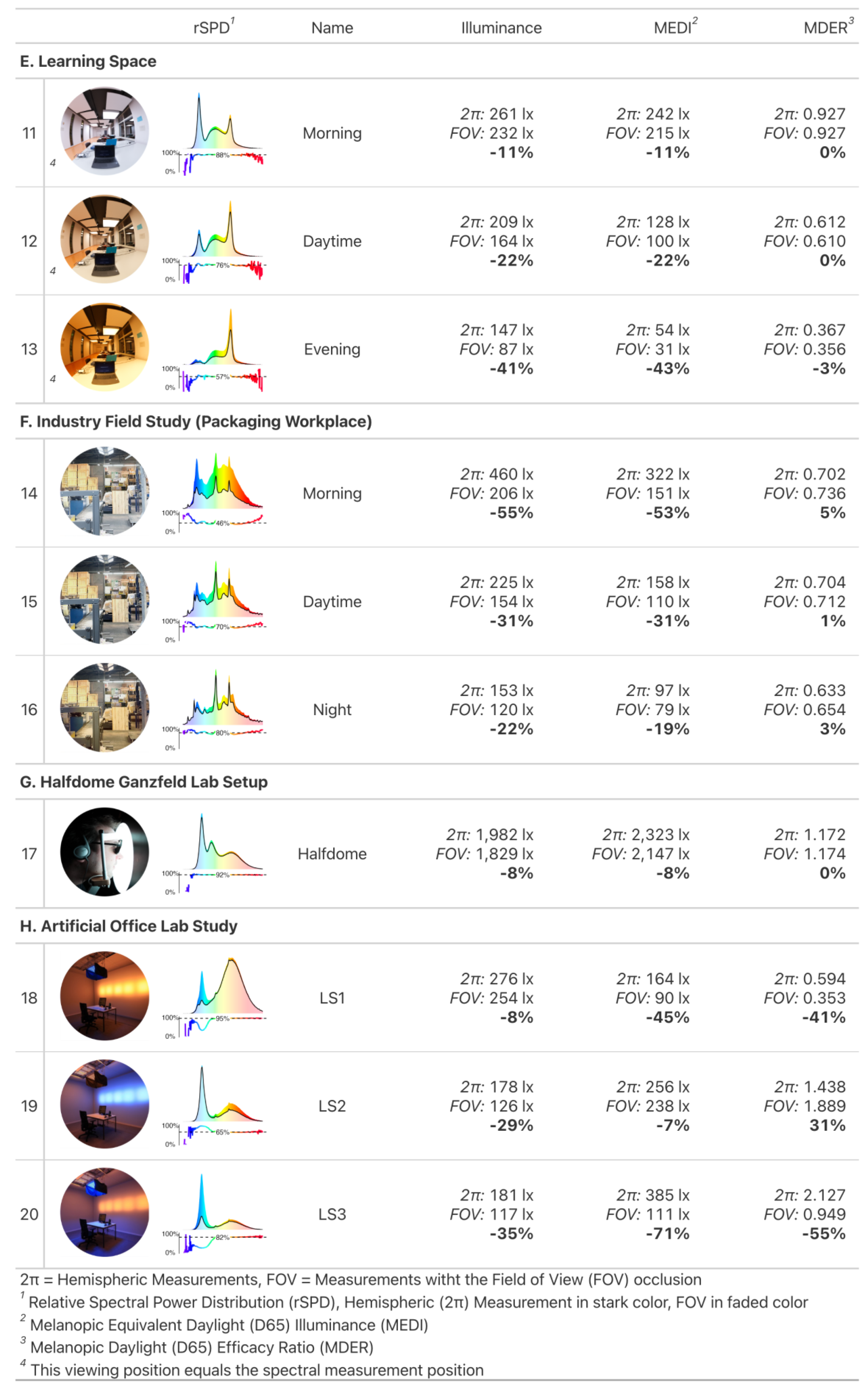
Disclaimer/Publisher’s Note: The statements, opinions and data contained in all publications are solely those of the individual author(s) and contributor(s) and not of MDPI and/or the editor(s). MDPI and/or the editor(s) disclaim responsibility for any injury to people or property resulting from any ideas, methods, instructions or products referred to in the content. |
© 2023 by the authors. Licensee MDPI, Basel, Switzerland. This article is an open access article distributed under the terms and conditions of the Creative Commons Attribution (CC BY) license (http://creativecommons.org/licenses/by/4.0/).





